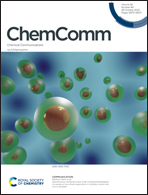Reaction of 2,5-dihydroxy-[1,4]-benzoquinone with nucleophiles – ipso-substitution vs. addition/elimination†
Abstract
2,5-Dihydroxy-[1,4]-benzoquinone (DHBQ) reacts readily with secondary amines to 2,5-diamino compounds and with thiols to the corresponding 2,5-dithioether derivatives. The literature has been inconclusive about the detailed mechanism, as both ipso-substitution at C-2/C-5 and the sequence of C-3/C-6 addition and C-2/C-5 elimination would give exactly the same products. By means of selectively 13C isotopically labelled DHBQ it was demonstrated that the reaction with morpholine is an ipso-substitution, while the reaction with benzenethiol and 1-hexanethiol proceeds according to the addition/elimination mechanism, and the reaction with the respective thiolates according to both mechanisms in parallel. Strongly acidic media cause a peculiar “OH-fluxuational” effect in DHBQ with the two quinone oxygens and the two hydroxy groups changing positions relative to the carbon skeleton while maintaining the 2,5-dihydroxy-[1,4]-diketo pattern. With this study, the mechanism of the unwanted nitrogen and sulfur fixation in cellulose fiber processing and during degradation could be better understood.
![Graphical abstract: Reaction of 2,5-dihydroxy-[1,4]-benzoquinone with nucleophiles – ipso-substitution vs. addition/elimination](/en/Image/Get?imageInfo.ImageType=GA&imageInfo.ImageIdentifier.ManuscriptID=D0CC04748A&imageInfo.ImageIdentifier.Year=2020)


 Please wait while we load your content...
Please wait while we load your content...